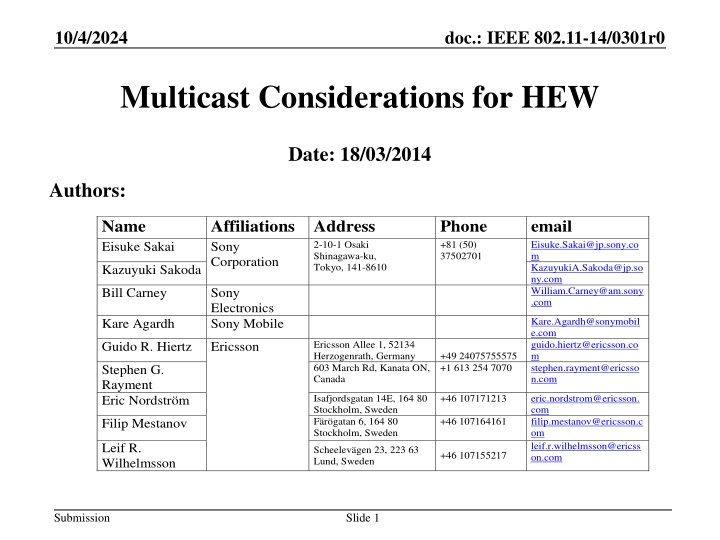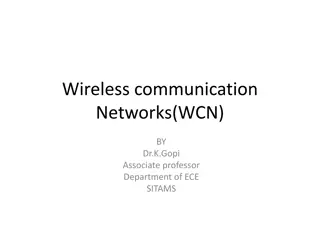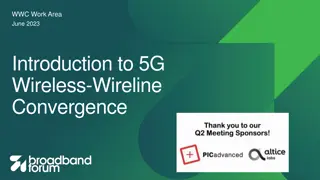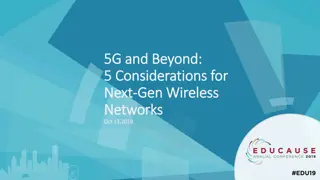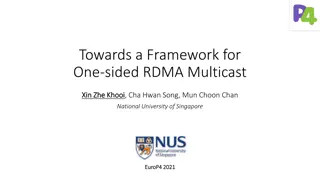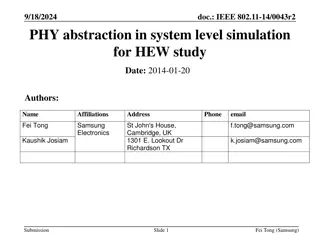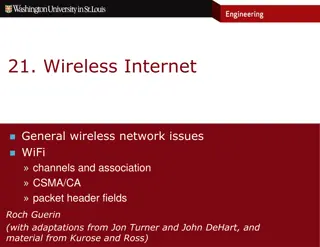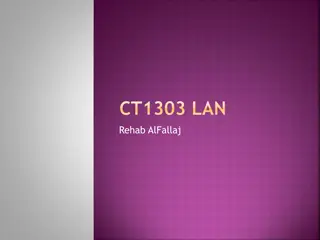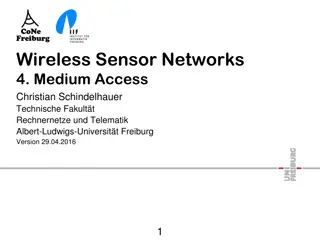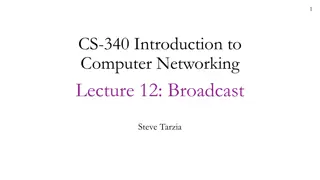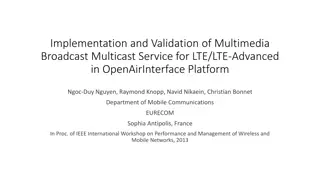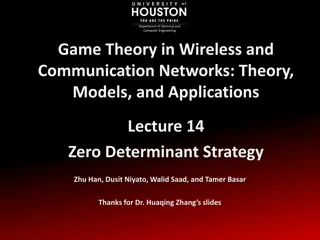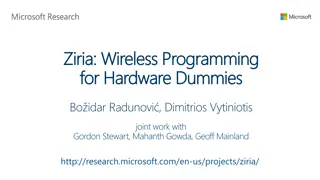Multicast Considerations for High Efficiency Wireless (HEW) Networks
Discusses the unique characteristics and challenges of distributing the same content to a large number of devices in dense deployment scenarios, focusing on multicast communication. Emphasizes the need for efficient solutions in HEW to enhance multicast communication for scenarios such as video distribution in crowded venues. Highlights the importance of considering additional multicast enhancements for achieving the intended usage model in HEW.
Download Presentation

Please find below an Image/Link to download the presentation.
The content on the website is provided AS IS for your information and personal use only. It may not be sold, licensed, or shared on other websites without obtaining consent from the author.If you encounter any issues during the download, it is possible that the publisher has removed the file from their server.
You are allowed to download the files provided on this website for personal or commercial use, subject to the condition that they are used lawfully. All files are the property of their respective owners.
The content on the website is provided AS IS for your information and personal use only. It may not be sold, licensed, or shared on other websites without obtaining consent from the author.
E N D
Presentation Transcript
10/4/2024 doc.: IEEE 802.11-14/0301r0 Multicast Considerations for HEW Date: 18/03/2014 Authors: Name Eisuke Sakai Affiliations Address Sony Corporation Phone +81 (50) 37502701 email Eisuke.Sakai@jp.sony.co m KazuyukiA.Sakoda@jp.so ny.com William.Carney@am.sony .com 2-10-1 Osaki Shinagawa-ku, Tokyo, 141-8610 Kazuyuki Sakoda Bill Carney Sony Electronics Sony Mobile Kare.Agardh@sonymobil e.com guido.hiertz@ericsson.co m stephen.rayment@ericsso n.com Kare Agardh Ericsson Allee 1, 52134 Herzogenrath, Germany 603 March Rd, Kanata ON, Canada Guido R. Hiertz Ericsson +49 24075755575 +1 613 254 7070 Stephen G. Rayment Eric Nordstr m +46 107171213 Isafjordsgatan 14E, 164 80 Stockholm, Sweden F r gatan 6, 164 80 Stockholm, Sweden eric.nordstrom@ericsson. com filip.mestanov@ericsson.c om leif.r.wilhelmsson@ericss on.com +46 107164161 Filip Mestanov Leif R. Wilhelmsson Scheelev gen 23, 223 63 Lund, Sweden +46 107155217 Submission Slide 1
10/4/2024 doc.: IEEE 802.11-14/0301r0 Name Kiseon Ryu Affiliations Address LG Electronics Phone email kiseon.ryu@lge.com wookbong.lee@lge.com Wookbong Lee hg.cho@lge.com HanGyu Cho inoue.yasuhiko@lab.ntt.c o.jp Yasuhiko Inoue NTT Toshiba tsuguhide.aoki@toshiba.c o.jp tomo.adachi@toshiba.co.j p guoqing.c.li@intel.com Tsuguhide Aoki Tomoko Adachi Guoqing Li Intel leileiw@marvell.com Lei Wang Marvell yakunsun@marvell.com Yakun Sun Submission Slide 2
10/4/2024 doc.: IEEE 802.11-14/0301r0 Abstract Discuss the unique characteristics of dense deployment scenarios receiving the same contents In particular: Video distribution via multicast Propose simulation scenarios to cover the multicast communication usage model that is critical to realizing the specific use cases Submission Slide 3
10/4/2024 doc.: IEEE 802.11-14/0301r0 Introduction Possible usage model in HEW Many people in a stadium or concert arena watch the same video (e.g., stream of a football game or close-up of performer) with their phones/tablets. An advertisement or dedicated content in an airport such as news channels with respect to each country is broadcasted only to the people who want to receive it. Students in a classroom watch single contents of a textbook. Technical conditions: Dozens/hundreds of STAs within a short distance (Dense environment) Simultaneous, single video contents distribution. To ensure the contents are delivered with quality and low latency, high efficiency communication is essential Thus, this usage model should be in the target scope of HEW and provided for in the corresponding evaluation methodology. Submission Slide 4
10/4/2024 doc.: IEEE 802.11-14/0301r0 Multicast Enhancement to Achieve the Intended HEW Usage Model Unicast is NOT suited to distribute the same content to vast number of STAs in close proximity Multicast is preferred in terms of the usage model and highest efficiency 11aa provides enhanced multicast, however, by itself, it may not be sufficient to cover use case envisioned by HEW Additional multicast enhancements in HEW should be considered For example, 11aa scheme may not provide high efficiency that HEW is targeting Efficient multicast communication in a highly dense environment should be covered Further discussions in HEW for more efficient solutions for same content distribution scenario For example but not limited to, multicast enhancement on IEEE802.11-2012 and/or 11aa or using a new enhancement Slide 5 Submission
10/4/2024 doc.: IEEE 802.11-14/0301r0 Summary To fully address the highly dense use cases such as Stadiums, Arenas, Airports, Malls, and stations, potential multicast enhancements in HEW should be explored. Submission Slide 6
10/4/2024 doc.: IEEE 802.11-14/0301r0 Proposals It is necessary to extend simulation scenarios (11- 13/1001r5) to cover multicast communication usage model Submission Slide 7
10/4/2024 doc.: IEEE 802.11-14/0301r0 Existing Simulation Scenario 3 Traffic model (per each BSS) - TBD Traffic definition A C The # of STAs is too small for the usage model # Source/Sink Name Flow specific paramters Dowlink D1 AP/STA1 to AP/STA10 AP/STA11 to AP/STA20 AP/STA21 to AP/STA30 Highly compressed video (streaming) Web browsing T2 D2 T4 TCP based streaming does not allow multicast D3 Local file transfer T3 Uplink U1 STA1/AP to STA10/AP Highly compressed video (streaming) UL TCP ACKs Web browsing: UL TCP ACKs Local file transfer U2 STA11/AP to STA20/AP STA21/AP to STA30/AP U3 T3 Submission Slide 8
10/4/2024 doc.: IEEE 802.11-14/0301r0 Proposed Amendment to Simulation Scenario 3 Traffic model (per each BSS) - TBD Traffic definition A C # Source/Sink Name Flow specific paramters Dowlink D1 AP/STA1 to AP/STA10 AP/STA11 to AP/STA20 AP/STA21 to AP/STA30 AP/STA31 to AP/STA 70 Highly compressed video (streaming) Web browsing T2 D2 T4 D3 Local file transfer T3 - New source/sink and traffic for multicast streaming should be defined There should be no data traffic from U4 D4 Multicast Video Streaming T8 Uplink U1 STA1/AP to STA10/AP Highly compressed video (streaming) UL TCP ACKs Web browsing: UL TCP ACKs Local file transfer - U2 STA11/AP to STA20/AP STA21/AP to STA30/AP STA/AP31 to STA/AP 70 U3 T3 U4 - Submission Slide 9
10/4/2024 doc.: IEEE 802.11-14/0301r0 Existing Simulation Scenario 3 - None of the proposed traffic models assumes one-way traffic base on UDP/IP and does not match multicast video streaming Traffic Model # Description Traffic model name Application traffic (Forward / Backward) Application Load (Mbps) (Forward / Backward) A-MPDU Size (B) (Forward / Backward) T1 FTP/TCP transfer of large file within local network Local file transfer FTP file transfer / FTP TCP ack Full buffer / 0.1 Max A-MPDU / 64 T2 Lightly compressed video T3 Internet streaming video/audio 4k video streaming Online game server Management: Beacon T4 T5 T6 T7 Managgeemnt: Probe requests Submission Slide 10
10/4/2024 doc.: IEEE 802.11-14/0301r0 Proposed Amendment to Simulation Scenario 3 - A new traffic model for multicast streaming should be defined Traffic Model # Description Traffic model name Application traffic (Forward / Backward) Application Load (Mbps) (Forward / Backward) A-MPDU Size (B) (Forward / Backward) T1 FTP/TCP transfer of large file within local network Local file transfer FTP file transfer / FTP TCP ack Full buffer / 0.1 Max A-MPDU / 64 T2 Lightly compressed video T3 Internet streaming video/audio 4k video streaming Online game server Management: Beacon T4 T5 T6 T7 Managgeemnt: Probe requests Multicast Video Streaming T8 UDP/IP transfer of compressed video streaming UDP packet transfer/Nothing 3-6Mbps/Nothing Submission Slide 11
10/4/2024 doc.: IEEE 802.11-14/0301r0 Proposal for New Traffic Model Descriptions We define Multicast Video Streaming Traffic Model Multicast Video Streaming is one-way video traffic from AP to STAs The video traffic is generated from a video server, and traverses multiple hops in the internet before arriving at AP for transmission to STA. Station layer model AP generates video frames at application layer. Because the traffic from AP to station has experienced network jitter, it can be modelled the same way as the traffic model of video streaming. The video traffic goes through UDP/IP layer and then to MAC layer. Video traffic generation Traffic model from AP to station: use the same steps in video streaming traffic model Evaluation metrics MAC throughput, latency We assume bit rate for video streaming 6 Mbps (1080/30p AVC) and 3 Mbps (1080/30p HEVC) multicast streaming Submission Slide 12
10/4/2024 doc.: IEEE 802.11-14/0301r0 BACKUP Submission Slide 13
10/4/2024 doc.: IEEE 802.11-14/0301r0 Expected number of multicast receiving STAs Scenario 3 (Stadium use case, R=12m) Assume there are 2.2 seats per 1m2. Assume audience of 5% seats uses multicast service. R=12m There are about 2.2 seats/m2 in typical stadium. -> about 40 STAs are expected to receive multicast video packets in each cell (BSS). Submission Slide 14
